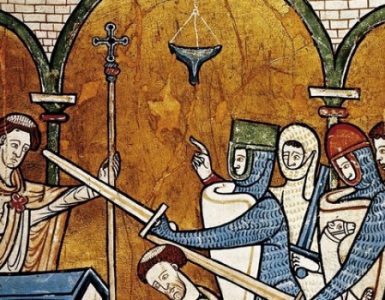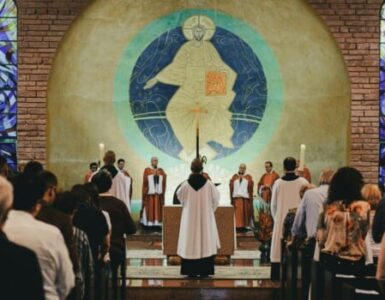Near the end of the movie As Good as it Gets, Jack Nicholson’s obsessive-compulsive character, Melvin Udall, gives a great compliment to his would-be girlfriend, waitress Carol: “I might be the only person on the face of the earth that knows you’re the greatest woman on earth…I think most people miss that about you. And I watch them wondering how they can watch you bring their food and clear their tables and never get that they just met the greatest woman alive!”
For all his flaws, Melvin saw something special and unique in Carol. Humanity, however, is fallen, and our view of each other distorted. In our society we have experienced recent protests over racism including murderous riots and looting. Angry groups have pulled down statues. Police have been demonized. So many have been looking at others with hate in their hearts.
In the 19th chapter of the Gospel of Matthew, some pharisees asked Jesus if he thought it lawful for a man to divorce his wife, and if so why did Moses allow it. Jesus replied, “Because of the hardness of your hearts, Moses allowed you to divorce your wives, but from the beginning it was not so” (Mt 19:8). In his seminal work the “Theology of the Body” (TOB), Pope John Paul II spent a great deal of time looking into that last statement of Jesus: “from the beginning it was not so.”
We know from beginning of the Bible, that “the man and his wife were both naked, yet they felt no shame” (Gn 2:25). What was it about “the beginning” that caused them to have no shame about their bodies, and be totally comfortable with their nakedness? JPII called this “original nakedness”. Adam and Eve were in that state because they had not yet crossed the threshold of sin.
John Paul II dove deep into “the beginning” in his catechesis on the Theology of the Body. How did man and woman look at each other before they brought sin into the world by disobeying God? Today, because our first parents sinned against God, we have inherited their fallen nature in the form of original sin. “Revelation gives us the certainty of faith that the whole of human history is marked by the original fault freely committed by our first parents” (CCC 390). Eve took some of the forbidden fruit and ate it “and also gave some to her husband, who was with her, and he ate it. Then the eyes of both of them were opened, and they knew that they were naked; so they sewed fig leaves together and made loincloths for themselves” (Gen 2:6-7). What changed that their eyes were opened so that they knew they were naked and felt ashamed and had to clothe themselves?
We are not able to see others as Adam and Eve saw each other before their fall from grace, in their original nakedness. In the beginning there were virginal forests, pristine and unpolluted oceans teaming with life, air that was immaculately pure, and a man and a woman who saw each other as God created them. The sins of lust, greed, and pride were as yet unknown. They saw each other as beautiful, unique, non-repeatable creations, and they loved with an agape love – the total, self-giving love of God. Adam and Eve were naked, and were not ashamed or self-conscious. They were naked without shame, and they loved each other for who they were. They loved each other and they loved God, as Jesus would command: ”You shall love your neighbor as yourself” (Mt 22:39).
In the Theology of the Body, John Paul II taught that original nakedness is not something that occurred by accident. Understanding it is key to understanding who God created us to be “in the beginning” and to knowing how we should strive to look at our fellow human beings in the world today. According to world renown TOB scholar Christopher West, the concept of original nakedness “indicates a total defenselessness before the other, an absence of barriers, because of a total trust in their mutual exchange” (TOB 1 Course). In the beginning, when man and woman looked at each other, they really saw each other. They experienced profound intimacy. In the beginning, human beings did not merely look at each other, they saw and knew each other fully.
Our first ancestors were the original human beings created by God. JPII called those who came after, “historical man”. There is a boundary between historical man and original man that cannot be crossed. We cannot see each other today as they saw each other in the beginning. We cannot love as they loved. We perceive each other today through the tinted “lenses” of our fallen nature. It’s as if we look at others through sunglasses that can’t be completely removed and that are distorted by the fall of humanity that was original sin. In this state, what can be done?
We can strive, in our fallenness, to see beyond our fallen natures through which we view those around us. We can strive to start to view and treat others differently; to start to look at other human beings as unique and unrepeatable and as amazing creations chosen by God’s eternal love; to seek the face of Jesus Christ in each and every person. God sees each and every one of his created sons and daughters and even knows “the hairs of your head” (Lk 12:7). We must strain and stretch ourselves to do the same. It is not easy.
It can start simply, though. A smile at a barista in the morning, “good morning” passing someone on a hiking trail, “peace be with you” to the one who cuts me off on the freeway, refraining from gossip. We will never see others perfectly or love perfectly as God does, but we can do better valuing others more, loving more, and forgiving quickly. That means that we must love all of our brothers and sisters, not only those we agree with or who look or speak like us. As Jesus said,
“You have heard that it was said, ‘You shall love your neighbor and hate your enemy’, but I say to you, love your enemies, and pray for those who persecute you” (Mt 5:43-44).
Seven years ago I became committed to a daily prayer life, and let Jesus into my heart for the first time. That changed my life. I began to see people differently. As Jesus started to transform me, I sought his face in others. That process was not easy and did not happen overnight. But eventually my relationships started to improve as did most encounters I had with others every day. I had been an arrogant, cocky, and unapproachable person. But after I started to see and treat others differently, I became a better boss and gradually became a servant leader; I reconciled with my sister and learned that she had also found the Lord; my wife and I started to find peace and a more loving, attentive way to be in our marriage. I still have miles to go on that journey, but striving to see and treat others differently is a game-changer in life.
Perceiving others differently, and ultimately loving them more deeply, is a key to starting a paradigm shift in our world. We look, but we do not see. Every day we encounter other human beings – the pinnacle of creation in our vast universe – and the reaction is too often: so what? We must start to see all of our brothers and sisters in this world as beautiful and non-repeatable, and uniquely endowed by our creator with special and amazing gifts.
✠
Photo by David Rodrigo on Unsplash














